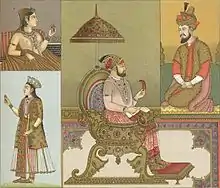
Late 19th century "Costume of India - Moguls" picture depicting Mogul woman (upper left), Mogul Emperor Farrukhsiyar (center) died 1719, and Emperor Humayun (upper right), died in 1556
Farzi refers to an outer garment of the Mughal court. It was a coat with short sleeves and fur collars, opened in front. The length was shorter than Jama. Farzi was a winter's garment. Mughal emperors and courtiers were wearing it over the Jama, fastened with a decorated piece of cloth, i.e., Katzeb around the waist area with loosely hanging ends. Farzi was one of the costumes given in Khilat (robes of honour) to the Mughal nobles and other courtiers. The coat was very much famous in the 17th century among the royals.[1][2][3]
See also
References
- ↑ Itihas. Director of State Archives, Government of Andhra Pradesh. 1992. p. 40.
- ↑ Sherwani, Haroon Khan (1974). History of Medieval Deccan, 1295-1724: Mainly cultural aspects. Copies can be had from Director of Print. and Publication Bureau, Government of Andhra Pradesh. p. 223.
- ↑ Mohamed Nasr. A Study Of Mughal Emperial Costumes And Designs During 16th And 17th Century.
This article is issued from Wikipedia. The text is licensed under Creative Commons - Attribution - Sharealike. Additional terms may apply for the media files.